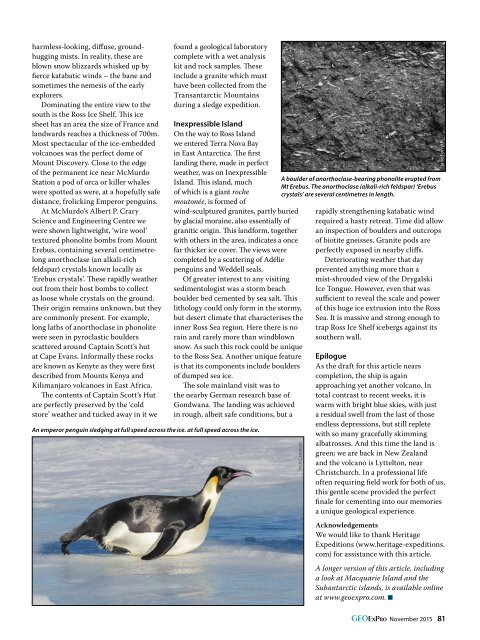Iraqi Kurdistan All in the Timing
GEO_ExPro_v12i6
GEO_ExPro_v12i6
You also want an ePaper? Increase the reach of your titles
YUMPU automatically turns print PDFs into web optimized ePapers that Google loves.
harmless-look<strong>in</strong>g, diffuse, groundhugg<strong>in</strong>g<br />
mists. In reality, <strong>the</strong>se are<br />
blown snow blizzards whisked up by<br />
fierce katabatic w<strong>in</strong>ds – <strong>the</strong> bane and<br />
sometimes <strong>the</strong> nemesis of <strong>the</strong> early<br />
explorers.<br />
Dom<strong>in</strong>at<strong>in</strong>g <strong>the</strong> entire view to <strong>the</strong><br />
south is <strong>the</strong> Ross Ice Shelf. This ice<br />
sheet has an area <strong>the</strong> size of France and<br />
landwards reaches a thickness of 700m.<br />
Most spectacular of <strong>the</strong> ice-embedded<br />
volcanoes was <strong>the</strong> perfect dome of<br />
Mount Discovery. Close to <strong>the</strong> edge<br />
of <strong>the</strong> permanent ice near McMurdo<br />
Station a pod of orca or killer whales<br />
were spotted as were, at a hopefully safe<br />
distance, frolick<strong>in</strong>g Emperor pengu<strong>in</strong>s.<br />
At McMurdo’s Albert P. Crary<br />
Science and Eng<strong>in</strong>eer<strong>in</strong>g Centre we<br />
were shown lightweight, ‘wire wool’<br />
textured phonolite bombs from Mount<br />
Erebus, conta<strong>in</strong><strong>in</strong>g several centimetrelong<br />
anorthoclase (an alkali-rich<br />
feldspar) crystals known locally as<br />
‘Erebus crystals’. These rapidly wea<strong>the</strong>r<br />
out from <strong>the</strong>ir host bombs to collect<br />
as loose whole crystals on <strong>the</strong> ground.<br />
Their orig<strong>in</strong> rema<strong>in</strong>s unknown, but <strong>the</strong>y<br />
are commonly present. For example,<br />
long laths of anorthoclase <strong>in</strong> phonolite<br />
were seen <strong>in</strong> pyroclastic boulders<br />
scattered around Capta<strong>in</strong> Scott’s hut<br />
at Cape Evans. Informally <strong>the</strong>se rocks<br />
are known as Kenyte as <strong>the</strong>y were first<br />
described from Mounts Kenya and<br />
Kilimanjaro volcanoes <strong>in</strong> East Africa.<br />
The contents of Capta<strong>in</strong> Scott’s Hut<br />
are perfectly preserved by <strong>the</strong> ‘cold<br />
store’ wea<strong>the</strong>r and tucked away <strong>in</strong> it we<br />
found a geological laboratory<br />
complete with a wet analysis<br />
kit and rock samples. These<br />
<strong>in</strong>clude a granite which must<br />
have been collected from <strong>the</strong><br />
Transantarctic Mounta<strong>in</strong>s<br />
dur<strong>in</strong>g a sledge expedition.<br />
Inexpressible Island<br />
On <strong>the</strong> way to Ross Island<br />
we entered Terra Nova Bay<br />
<strong>in</strong> East Antarctica. The first<br />
land<strong>in</strong>g <strong>the</strong>re, made <strong>in</strong> perfect<br />
wea<strong>the</strong>r, was on Inexpressible<br />
Island. This island, much<br />
of which is a giant roche<br />
moutonée, is formed of<br />
w<strong>in</strong>d-sculptured granites, partly buried<br />
by glacial mora<strong>in</strong>e, also essentially of<br />
granitic orig<strong>in</strong>. This landform, toge<strong>the</strong>r<br />
with o<strong>the</strong>rs <strong>in</strong> <strong>the</strong> area, <strong>in</strong>dicates a once<br />
far thicker ice cover. The views were<br />
completed by a scatter<strong>in</strong>g of Adélie<br />
pengu<strong>in</strong>s and Weddell seals.<br />
Of greater <strong>in</strong>terest to any visit<strong>in</strong>g<br />
sedimentologist was a storm beach<br />
boulder bed cemented by sea salt. This<br />
lithology could only form <strong>in</strong> <strong>the</strong> stormy,<br />
but desert climate that characterises <strong>the</strong><br />
<strong>in</strong>ner Ross Sea region. Here <strong>the</strong>re is no<br />
ra<strong>in</strong> and rarely more than w<strong>in</strong>dblown<br />
snow. As such this rock could be unique<br />
to <strong>the</strong> Ross Sea. Ano<strong>the</strong>r unique feature<br />
is that its components <strong>in</strong>clude boulders<br />
of dumped sea ice.<br />
The sole ma<strong>in</strong>land visit was to<br />
<strong>the</strong> nearby German research base of<br />
Gondwana. The land<strong>in</strong>g was achieved<br />
<strong>in</strong> rough, albeit safe conditions, but a<br />
An emperor pengu<strong>in</strong> sledg<strong>in</strong>g at full speed across <strong>the</strong> ice. at full speed across <strong>the</strong> ice.<br />
A boulder of anorthoclase-bear<strong>in</strong>g phonolite erupted from<br />
Mt Erebus. The anorthoclase (alkali-rich feldspar) ‘Erebus<br />
crystals’ are several centimetres <strong>in</strong> length.<br />
Nick Cameron<br />
Jane Forsyth<br />
rapidly streng<strong>the</strong>n<strong>in</strong>g katabatic w<strong>in</strong>d<br />
required a hasty retreat. Time did allow<br />
an <strong>in</strong>spection of boulders and outcrops<br />
of biotite gneisses. Granite pods are<br />
perfectly exposed <strong>in</strong> nearby cliffs.<br />
Deteriorat<strong>in</strong>g wea<strong>the</strong>r that day<br />
prevented anyth<strong>in</strong>g more than a<br />
mist-shrouded view of <strong>the</strong> Drygalski<br />
Ice Tongue. However, even that was<br />
sufficient to reveal <strong>the</strong> scale and power<br />
of this huge ice extrusion <strong>in</strong>to <strong>the</strong> Ross<br />
Sea. It is massive and strong enough to<br />
trap Ross Ice Shelf icebergs aga<strong>in</strong>st its<br />
sou<strong>the</strong>rn wall.<br />
Epilogue<br />
As <strong>the</strong> draft for this article nears<br />
completion, <strong>the</strong> ship is aga<strong>in</strong><br />
approach<strong>in</strong>g yet ano<strong>the</strong>r volcano. In<br />
total contrast to recent weeks, it is<br />
warm with bright blue skies, with just<br />
a residual swell from <strong>the</strong> last of those<br />
endless depressions, but still replete<br />
with so many gracefully skimm<strong>in</strong>g<br />
albatrosses. And this time <strong>the</strong> land is<br />
green; we are back <strong>in</strong> New Zealand<br />
and <strong>the</strong> volcano is Lyttelton, near<br />
Christchurch. In a professional life<br />
often requir<strong>in</strong>g field work for both of us,<br />
this gentle scene provided <strong>the</strong> perfect<br />
f<strong>in</strong>ale for cement<strong>in</strong>g <strong>in</strong>to our memories<br />
a unique geological experience.<br />
Acknowledgements<br />
We would like to thank Heritage<br />
Expeditions (www.heritage-expeditions.<br />
com) for assistance with this article.<br />
A longer version of this article, <strong>in</strong>clud<strong>in</strong>g<br />
a look at Macquarie Island and <strong>the</strong><br />
Subantarctic islands, is available onl<strong>in</strong>e<br />
at www.geoexpro.com.<br />
GEOExPro November 2015 81


